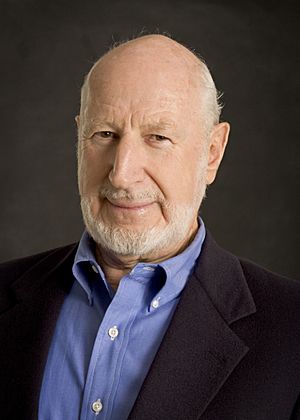Norman Abramson facts for kids
Quick facts for kids
Norman M. Abramson
|
|
|---|---|
 |
|
| Born | April 1, 1932 |
| Died | December 1, 2020 (aged 88) |
| Nationality | American |
| Alma mater | Stanford University Harvard University |
| Awards | IEEE Alexander Graham Bell Medal (2007) |
| Scientific career | |
| Fields | Electrical Engineering and Computer Sciences |
| Institutions | University of Hawaii |
| Thesis | Application of "comparison of experiments" to radar detection and coding problems (1958) |
| Doctoral advisor | Willis Harman |
| Doctoral students | Thomas M. Cover Robert A. Scholtz |
Norman Manuel Abramson (born April 1, 1932 – died December 1, 2020) was a smart American engineer and computer scientist. He is best known for creating the ALOHAnet system. This system helped computers talk to each other without wires, like early Wi-Fi. His work was very important for how we use the internet today.
Contents
Early Life and Education
Norman Abramson was born on April 1, 1932, in Boston, Massachusetts. His parents, Edward and Esther, had moved there from other countries. His father was from Lithuania and worked as a photographer. His mother was from Ukraine and took care of their home.
Norman went to public schools in Boston. He was very good at math and science. He earned a degree in physics from Harvard University in 1953. Later, he got another degree in physics from UCLA in 1955. He then earned his highest degree, a Ph.D., in electrical engineering from Stanford University in 1958. His studies at Stanford focused on how information is sent and received.
Norman Abramson's Career
After finishing his studies, Abramson worked as an engineer at Hughes Aircraft Company. From 1955 to 1965, he taught at Stanford University. He also visited the University of California at Berkeley as a professor in 1966.
In 1968, he moved to the University of Hawaii. There, he became a professor of both Electrical Engineering and Computer Science. His early research included studying radar signal characteristics and how to collect data. He also worked on frequency modulation and sending information digitally. He studied error correcting codes and how computers can learn and recognize patterns.
Creating the ALOHAnet System
One of Abramson's most important projects at the University of Hawaii was to develop new radio technology. Hawaii is far from the mainland United States. The school needed a way to send and receive data easily. The project received money from the Advanced Research Projects Agency.
A big new idea in his technology was to break data into small pieces called packets. If a packet got lost, it could be sent again. This allowed computers to access data randomly, not just in a set order. This idea was similar to what was being developed for ARPAnet, which was an early version of the Internet.
His team created a radio network called ALOHAnet in 1971. The name "aloha" has a special meaning in Hawaiian. ALOHAnet became a key part of modern wireless communication. It also helped shape how Ethernet-based communications work today.
Abramson taught at the University of Hawaii until he retired in 1994. After retiring, he helped start a company called Aloha Networks in San Francisco. He worked there as the Chief Technology Officer (CTO).
Family and Later Life
Norman Abramson had two children with his wife, Joan: a son named Mark and a daughter named Cairn. Sadly, his wife passed away six years before him.
Norman Abramson died on December 1, 2020. He passed away at his home in San Francisco. He had complications from skin cancer that had spread to his lungs.
Awards and Honors
Norman Abramson received many awards for his important work:
- 1972: IEEE Sixth Region Achievement Award for his work on information theory and coding.
- 1980: IEEE Fellow Award for creating the ALOHA-System.
- 1992: Pacific Telecommunications Council 20th Anniversary Award for his leadership.
- 1995: IEEE Koji Kobayashi Computers and Communications Award for developing the ALOHA System.
- 1998: Golden Jubilee Award for Technological Innovation from the IEEE Information Theory Society. This was for inventing the first way for computers to access communication channels randomly.
- 2000: Technology Award from the German Eduard Rhein Foundation.
- 2007: IEEE Alexander Graham Bell Medal.
- 2011: C&C Prize.
See also
In Spanish: Norman Abramson para niños

